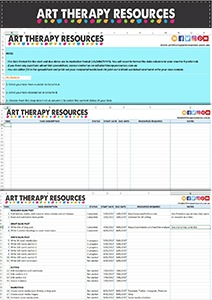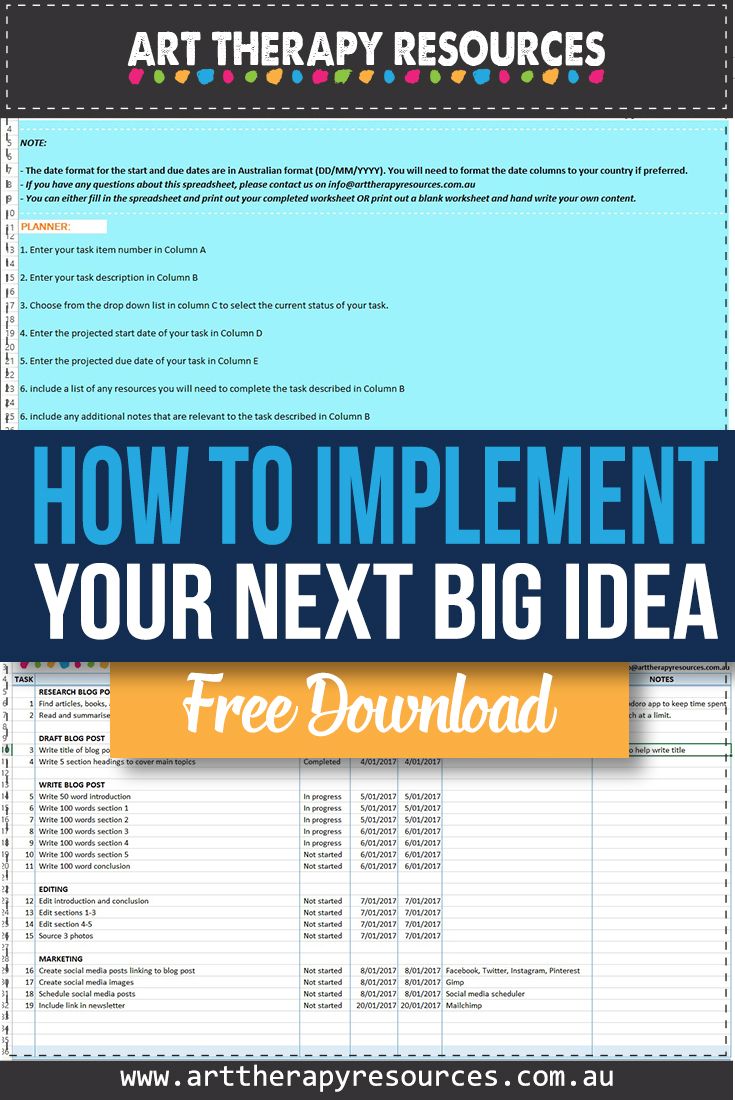THIS POST INCLUDES:
1. Big ideas for a therapy practice?
2. Do I need a big idea?
3. How to identify your big idea?
4. Steps to implement your big idea
5. Free Download Planning Template
BIG IDEAS FOR A THERAPY PRACTICE
Most of your time as a private practice art therapist will be spent on client work and the day-to-day running of your practice which includes both financial and administrative tasks.
After a while you may find that your private practice systems are in place and you have some mental space to consider what might be next for either your practice or you as an art therapist. You may start to wonder about broader ideas for your practice. These ideas might be much bigger than what you had previously imagined of regular client work.
Big ideas can take courage to step away from routines and regular safety nets. This courage typically means changes occur and sacrifices are made. Developing a new idea can also mean exposing your limitations and lack of skills that you need to develop. This can be confronting if you’re looking for immediate success.
Generating big ideas for your therapy practice is a good way to use your creative art therapist skillset to disrupt old thinking patterns, gain new perspectives, and develop new skills.
Even though big ideas are exciting, the reality is that for running your practice, gaining momentum is the most effective way of achieving your ideas. Using momentum moves you toward your goal one step at a time with consistency and good management of your time and resources.
DO I NEED A BIG IDEA?
The short answer is no, you do not need a big idea to be a successful art therapist. If you want a regular income from your private practice and you enjoy the sustainability of a steady flow of clients, then your time and effort should be spent on ensuring those goals are met. They are valid goals to have and allow you to manage your time and exposure to risk.
On the other hand, if you find your thoughts gravitating to expanding your practice beyond client work and into other avenues then it might be time to explore some bigger ideas to expand your goals.
Of course, it should be acknowledged that ‘big’ is a subjective measurement. One therapist might identify ‘big’ as adding more staff, whereas another therapist might envision ‘big’ as starting multiple practices throughout a state or other geographical region.
Everything is relative to what it means to you and your overall goals.
Big ideas are an exciting prospect, however, they also need to translate to actionable steps to ensure your ideas come to fruition.
HOW TO IDENTIFY YOUR BIG IDEA?
All ideas should go through a vetting process. Even if an idea sparks your interest, it may not be the best idea to implement in your business at that time or indefinitely. This doesn’t mean you have to abandon the idea completely. Instead, assessing your ideas allows you the opportunity to identify whether parts of an idea could be incorporated into your business.
The main benefit of a big idea is that it provides unlimited potential in how you can adapt and use it in your art therapy practice.
To help identify your idea, you can ask yourself the following questions:
- Does your idea offer a solution to a common problem?
- Does your idea speak to a targeted market?
- Do other practices have the same idea or similar? This can often be a proof of concept that your idea will work if others have already found success.
- Can you improve on the idea to make it more unique to your practice?
- Do you have support systems in place to develop and implement your idea?
- Can you see the potential obstacles and how to address them?
- Is your big idea focused on a specific outcome?
- Is this a short-term or long-term idea?
Once you work through these questions, you will begin to refine your idea and start to build the foundation of an idea that can be implemented.
STEPS TO IMPLEMENT YOUR BIG IDEA
One of the most important parts of implementing any new idea is refining it so that you are efficiently and effectively implementing the right idea. When the purpose of your idea is vague, you can waste time and resources by pursuing avenues in your idea that may not work out. No idea is guaranteed for success and every new idea contains a degree of risk, however, with some planning, you can refine and strategize to ensure that your idea has the best chance of success.
Below are some general steps to get you started in implementing your next big idea:
- Start with a list of all ideas that you are considering for your practice
- Refine the list and prioritize the idea that will have the most return on investment for your private practice
- Share your idea with others to identify the ideas that may resonate with others also
- Review your idea into its final iteration
- Develop a structured plan to implement your idea
- Identify the resources needed
- Set a deadline with strategic points along the way to implement your idea
- Test your idea in a small market where possible
- Launch your idea
- Review your idea and make changes where necessary
In previous posts, we’ve explored the process of using 30 days to create an ebook and 30 days to launch your first online course.
Both of these posts will provide a useful background to how you may want to structure implementing your next big idea.
As discussed before, maintaining momentum will be the biggest contributor to ensuring your big idea comes to fruition. The need to make decisions in your process will sometimes create delays if you become stuck on an idea or start to wade into perfectionist behaviours. Just remember, everything can be changed or refined later if your project changes direction.
Further reading
Below are some additional blog posts we’ve previously created that will provide some further help on identifying, developing, and implementing your next big idea:
ART THERAPY IDEAS
PLANNING
- 10 Useful Planning Tools for Your Business
- Planning Template for Your Art Therapy Practice
- Task Management Software For Art Therapy Planning
- How to Plan A Productive Year as a Therapist
PRODUCTIVITY
PROFITABILITY
TOOLS
FREE DOWNLOAD: Art Therapy Exercise
SIGN UP below to download the FREE Planning Template to help plan your next big idea!

BUILD YOUR ART THERAPY REFERENCE MATERIALS:
Pin this image to your Pinterest board.

SHARE KNOWLEDGE & PASS IT ON:
If you’ve enjoyed this post, please share it on Facebook, Twitter, Pinterest. Thank you!
